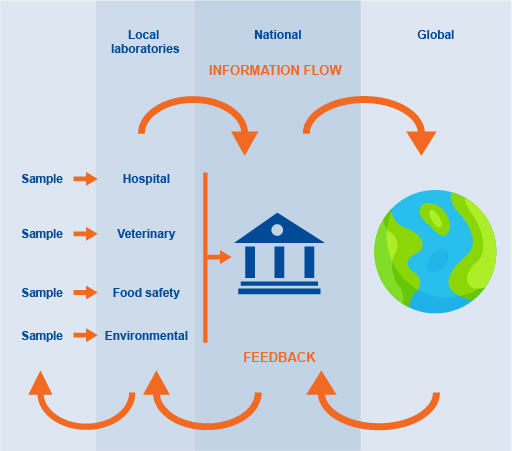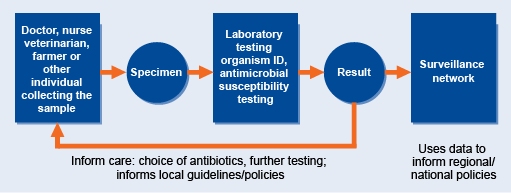2 Introducing AMR surveillance
AMR surveillance is the ongoing collection, analysis, interpretation and dissemination of data related to AMR.
Globally, AMR surveillance provides early warnings about the spread of new resistant strains of bacteria, revealing trends and outbreaks of infection. AMR surveillance is critical to tackling AMR, since the data it yields can help to inform the best treatment and care (the right drug at the right dosage for the right amount of time) for humans or animals at a local level, even where it is not possible to test individually. At regional and national levels, surveillance data informs intervention priorities and helps to identify gaps in service delivery. At a national level, the data guides planning and resource allocation, and informs policies and responses to patterns and trends.
For countries supported by the Fleming Fund, most AMR surveillance is carried out using a sentinel site approach. In this approach, rather than collecting data from every healthcare facility or laboratory in the country, a selection of sites are used. Ideally, these sites are chosen because they can represent the population of the country as a whole. Data is gathered from a number of hospital sites and laboratories, and is collated for use as regional or national surveillance data (Figure 2).
At the local level, a clinician, nurse, veterinarian or other AMR surveillance professional takes a sample and sends it to the laboratory to be tested. Laboratories routinely test samples to provide clinicians and veterinarians with information that is used to diagnose and treat infections (Figure 3), such as whether a bacterium is growing, what type of bacterium it is, and what drugs can be used to treat the infection.
Local surveillance practice comprises the following broad task areas, all of which are critical for good quality data:
- collecting/receiving specimens, and logging specimen and relevant clinical information
- performing tests
- monitoring and documenting data
- interpreting data
- reporting and communicating the test results to the person submitting the test
- reporting and communicating the results/data beyond the laboratory – locally, nationally and globally.
These tasks are undertaken by professionals working together across different roles.
In the next section you will think more about how your role might relate to AMR surveillance.
1 About this course





